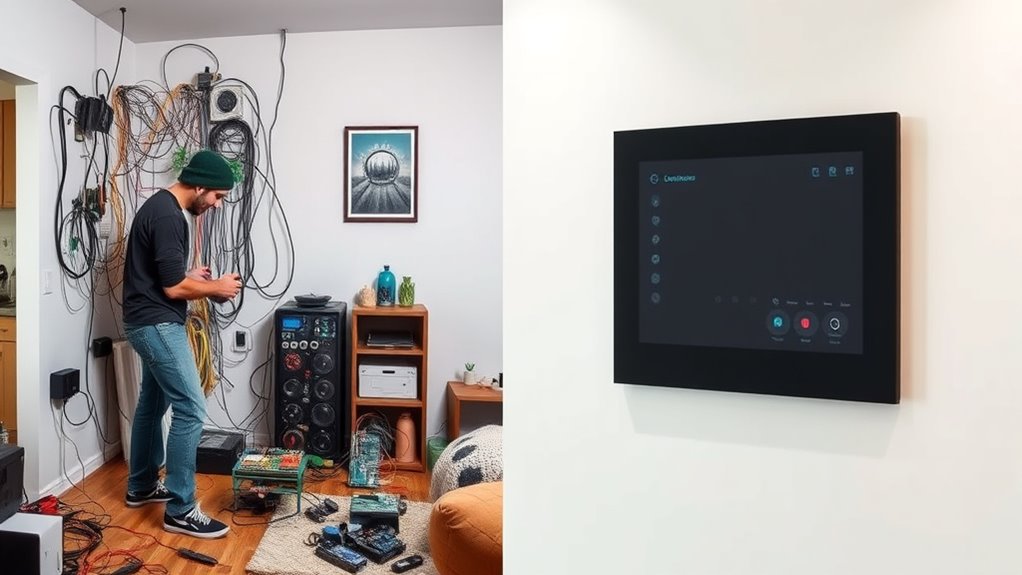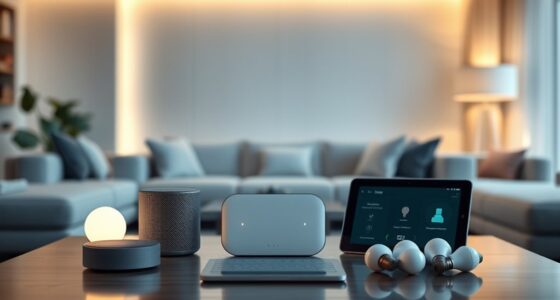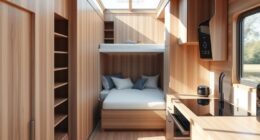When choosing between a DIY and professional smart home setup, consider your budget, technical skills, and desired reliability. DIY options let you customize and build systems your way, which can save money and give you a sense of accomplishment. However, professional installations offer seamless integration, reliable performance, and expert support, especially for security and complex automation. Both choices have pros and cons—if you keep exploring, you’ll find out which suits your home best.
Key Takeaways
- DIY setups offer customization and satisfaction but may lack the reliability and seamless integration of professional systems.
- Professional installations provide more reliable, calibrated, and scalable solutions with expert planning.
- DIY options are cost-effective initially but may require more troubleshooting and maintenance over time.
- Professionals ensure enhanced network security and system stability, reducing potential technical issues.
- Choice depends on skill level, budget, and desire for personalized control versus seamless, polished automation.

In the rapidly evolving world of technology, automation is transforming industries at an unprecedented pace. When it comes to smart homes, this transformation offers you incredible opportunities to enhance comfort, security, and efficiency. But it also raises a critical decision: should you go the DIY route or hire professionals to set up your smart home? Understanding the differences can help you make an informed choice.
If you decide to handle your smart home setup yourself, you’ll enjoy the satisfaction of building something tailored exactly to your preferences. DIY automation allows you to experiment with lighting control systems that can adapt to your daily routines, creating ambiance or energy savings with simple app commands. You might start with starter kits that include smart bulbs, switches, and hubs, connecting devices through Wi-Fi or Zigbee protocols. Integrating lighting control is straightforward, giving you the ability to turn lights on or off remotely, set schedules, or even sync lights with your entertainment system for immersive experiences.
DIY smart home setup offers customization and satisfaction with lighting control systems.
Security integration is another key aspect you can manage yourself. With many DIY kits, you can install cameras, door sensors, and smart locks, then link them to a central app. This setup enables real-time alerts, remote monitoring, and automation rules, like turning on lights when motion is detected or locking doors at certain times. However, while the process can be rewarding, it often requires a decent understanding of network configurations and compatibility issues. You might face challenges troubleshooting connectivity problems or ensuring that all components work seamlessly together, especially as your system grows more complex.
On the other hand, choosing professional installation means you get experts who can design a holistic, integrated system tailored to your home’s layout and your lifestyle. They’ll handle the technical details of lighting control, ensuring your lighting scenes are perfectly calibrated and responsive. Security integration is also polished and seamless, with professionals setting up systems that are more robust and reliable. They can optimize network security, so your smart home remains protected from hacking or breaches. The upfront cost is higher, but you gain peace of mind knowing that your system is built for reliability and future expandability.
Ultimately, your choice depends on your comfort with technology and how much time you’re willing to invest. DIY offers control and personalization, but it can be time-consuming and technically challenging. Professional setups come with a higher price tag but deliver a more integrated, reliable experience. Either way, automation is here to make your life easier—whether you build it yourself or rely on experts to bring your smart home vision to life.
Frequently Asked Questions
What Are the Initial Costs of DIY Versus Professional Setups?
When comparing initial costs, you find that DIY smart home setups typically cost less upfront, offering greater cost efficiency if you’re comfortable with tech. You can choose affordable devices and customize your system easily, saving money. Professional setups, on the other hand, usually involve higher initial costs due to installation fees and premium equipment but provide seamless integration and expert customization. Your choice depends on balancing your budget and desired customization options.
How Secure Are DIY Smart Home Systems Against Hacking?
You might wonder how secure your DIY smart home system is against hacking. Generally, DIY setups can be less secure due to cybersecurity vulnerabilities, especially if you’re not familiar with best practices. However, you can improve security by using strong encryption standards and regularly updating firmware. While they might not be as robust as professional systems, careful configuration can make your DIY setup reasonably safe from hacking threats.
Can DIY Installations Be Expanded Easily Over Time?
It’s a coincidence that your DIY smart home can grow with you, but scalability challenges are real. You can expand your system over time, but it might require extra planning and effort. Customization flexibility is a plus, allowing you to add new devices or features as needed. Just remember, the more you customize, the more you’ll need to troubleshoot and integrate, so stay patient and plan ahead for seamless upgrades.
What Is the Average Time Commitment for DIY Setup?
When considering a DIY setup, the time investment varies based on your skill requirements and the complexity of your smart home. You might spend several hours initially, especially if you’re learning new technologies, troubleshooting, or installing multiple devices. Expect it to take anywhere from a few hours to a full weekend, depending on your experience level. Keep in mind, a higher skill requirement may reduce overall time, but patience is key.
Do Professional Setups Include Ongoing Technical Support?
Yes, professional setups often include ongoing technical support, which means you get assistance with system maintenance and troubleshooting whenever needed. This support guarantees your smart home runs smoothly over time, saving you the hassle of figuring out issues on your own. With ongoing technical support, you can enjoy peace of mind knowing experts are there to help you maintain and optimize your system long-term.
Conclusion
Whether you go DIY or hire pros, your smart home will become an unstoppable fortress of convenience. With the right setup, you’ll control everything from lights to security with a mere flick of your finger—faster than you can blink! Don’t settle for ordinary; aim for a home so intelligent it practically runs itself. In this automation showdown, the only winner is your newfound superpower over everyday life. Prepare to live in a future so cool, it’ll blow your mind!









